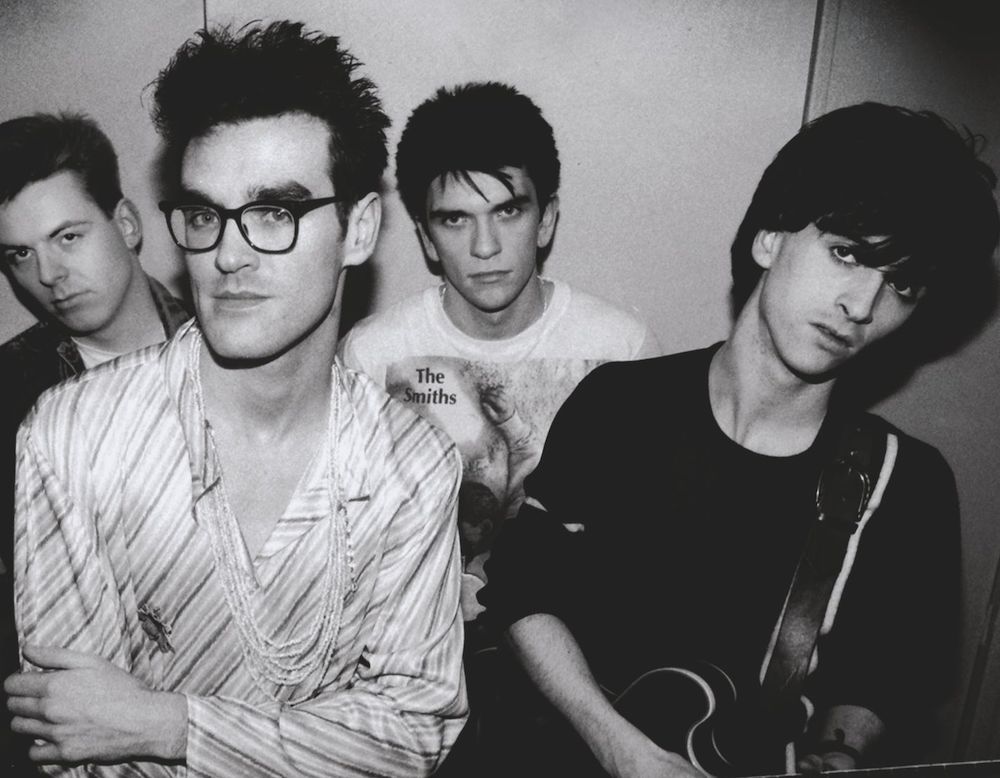In the seemingly infinite discussion of influence, Joy Division's place in the halls of music's most revered is just as sure as the band's equally esteemed mythos. Generations of fans old enough to have remembered the band's breakthrough in 1979, and the countless more born well after the 1980 suicide of Ian Curtis, hold the mercurial vocalist in almost messianic esteem. The lenses of celebrity often blur the cruel and unforgiving nature of reality, though, giving us a retrospective that too often ignores the context that, however small, was largely responsible for the art and music we were enjoying in the first place. Though understandably seen as the unfortunate catalyst for what would become New Order, the death of Ian Curtis is no less tragic even when cast in the positive light of his unparalleled influence and courage. And while New Order's acclaim and success is deserved and historic in its own right, the band's clear distinction both in sound and in scope separate it from the overwhelming, albeit brief, presence of Joy Division.
Perhaps the most profound and uncanny part of Joy Division's story is found in the band's vapor-like existence, spanning only two full-lengths and an EP. It's the kind of story the world of rock and roll readily mutates into lore, with the spectacle unfairly overshadowing the validity of the music itself. For Joy Division, the spectacle started even before the death of Curtis, with critics and fans alike taking immediate notice of the vocalist's onstage antics and his singularly haunting baritone. Thankfully, Curtis' immense vocal talent was accompanied by an equally talented band whose sense of atmosphere and damn near tangible dread made for the gloomiest of collaborations. While Peter Hook's high bass lines lay out a kind of distorted lamentation for the cold staccato drumming of Stephen Morris, Bernard Sumner painted electric broad strokes with riffs as heavy as metal and just as commanding. These four unassuming friends from Manchester just at the cusp of their twenties set their punk sentiments to an eerie tune, inadvertently setting into motion one of the most inarguably dominant sounds of the last three decades.
For all the well-documented aural and thematic fragility of Joy Division, their greatest impact likely lies in the powerful catharsis of their music. Paired with the mournfully kinetic sounds created by Hook, Sumner, and Morris, the baleful tone from Curtis purges any semblance of superficiality with an emotional delivery that's disturbingly believable. The two full-lengths (Unknown Pleasures and Closer) along with the 1978 EP and a handful of singles and posthumous releases speak to the understated bravery of Curtis, whose legacy is too often relegated to words like "misery" and "tragic." The rarity of Joy Division's uninhibited lyrical and musical vulnerability is nothing short of phenomenal given that its musicians were somehow able to match and complement the despair and energy emoting from the lyrics and delivery of Curtis. The issue of mental illness and its direct relationship with Joy Division's music is one that has no need of being separated simply for the fact that its precisely that characteristic that breathes life into the few songs the band created.
These ten tracks in no way represent the whole of Joy Division's catalog but rather attempt to reflect the gravity of the band's fleeting but inimitable sway over the music that followed. Though the music of Joy Division readily gives way to a sorrowful texture and atmosphere, its power lies at those auditory verges when the music stops and the listener sits stunned by the experience. Perhaps most importantly, the music here provides a commonality even at its darkest corners, with Curtis treading the cruel and razor-thin brink that separates the human condition from the perpetually looming reality of psychosis. Along with Hook, Sumner, and Morris, the dark brilliance of that journey was one that Curtis perhaps felt compelled to walk and, thankfully, share its darkest shadows. Almost 34 years after his death, those wavelengths of powerful gloom resonate as strongly as ever, reverberating an ironic sense of hope for the limitlessness of music at its most beautifully troubling.
10. "Disorder" (from Unknown Pleasures, 1979)
The song that arguably started it all: The first track from Joy Division's debut LP immediately kicks in the coldly subdued sound the band would inadvertently help pioneer. Beginning with Stephen Morris' hiccuped drums and Bernard Sumner's minimal but moving guitar work, the song's pace is exacting, gradually unraveling both lyrically and musically, with Ian Curtis' icy baritone punctuating the song's staccato rhythm. The convenience of retrospect reveals that Curtis' now well-documented struggle with epilepsy was apparent from the very beginning, and something the frontman perhaps unconsciously poured into songs like "Disorder." The song's gradual descent into sonic disarray is something that might have detracted from any other band whose vocalist wasn't Ian Curtis. He reverberates the word "feeling" in a fevered, isolated haze to close the song and to essentially begin Joy Division's tragic and influential story.
9. "The Eternal" (from Closer, 1980)
The penultimate track on what would be Joy Division's second and final full-length, "The Eternal" begins with an electric curtain of noise interrupted by Hook's bass line eerily thudding like a faint pulse. Sumner's keyboard work provides grounding for the otherwise ethereal opening to the song while Curtis at his most subdued sings the line, "Procession moves on/ the shouting is over," cutting through the ambient vapor like a knife. It comes as no surprise that the song readily translates to those darker, more extreme corners of the music world, with now-defunct American black metal pioneers Nachtmystium covering the song on a 7" single released in 2012. The song finds Curtis exchanging his coldly punctuated vocal style for one that's melodically fluid. The apparitional vocals float just inches above Sumner's haunting piano chords echoing alongside unnervingly distanced drumming. The song's spectral movement displays the core of what critics would label "gothic rock," but even more importantly it offers a glimpse into the dark fragility behind the ghostliness of Curtis' vocals.
8. "Atmosphere" (from Substance, 1988)
Initially released in France as an exclusive single in 1980, this song's original title was "Light And Blindness." Beginning with Morris' drum work providing an abbreviated rhythm, the song quickly sets into its pattern for Curtis' baritone croon. The synth orchestration provides a bleakly melodic ambiance against the lyrical theme of seclusion and self-disillusionment. Appropriately titled, the fluid pacing of the song constantly edges toward eruption but deliberately stops just short, letting the narrow space between notes serve as a kind of brooding ellipsis. A music video accompanied the song's re-release on 1988's singles compilation, Substance, showing hooded figures in a barren desert wasteland juxtaposed against candid photos of Curtis. Almost prayerful in its delivery, the song is at times both musically and lyrically hopeful, with Curtis pleading for emotional tangibility against the backdrop of the music's specter-like movement. Widely considered one of the band's finest songs, "Atmosphere" displays the kind of elegantly vulnerable songwriting that would define not just Joy Division's music but provide the influence for countless musicians and bands after them.
7. "Shadowplay" (from Unknown Pleasures, 1979)
Even in the more operatively post-punk sound of their first release, Joy Division's gothic rock tinges were unmistakable with songs like "Shadowplay." Hook's distinctive treble-flirting bass line and the metallic wail of Sumner's guitar serve as a kind of ominous call-and-response underscoring Curtis at his most vocally forceful. "In the shadowplay/ acting out your own death/ knowing no more," is a line likely to elicit groans if it weren't entrenched in the subdued but strangely frantic movement of the music. Sumner's minor-chord lead-out punctuates the song's final minute as Morris' drums provide a clipped yet echoing chill. The band's subtle but marked shift from the punk tendencies on Unknown Pleasures to the gothic atmospherics of Closer is completely natural and unsurprising. Though decidedly muted, the dark fringes of "Shadowplay" are still nonetheless impactful and, more importantly, they offer a glimpse into the band's brief but incomparably brilliant musical direction.
6. "Twenty Four Hours" (from Closer, 1980)
The normally understated rhythms of drummer Morris are briefly exchanged for a kinetic unpredictability on "Twenty Four Hours." When paired against the rest of Closer's largely melancholic pacing, the atypical dynamics of movement in "Twenty Four Hours" seem strange yet just as oddly appropriate. Joy Division's dynamic of melodically wavering between the quietly frantic and eerily calm is at the forefront of the song's four and a half minutes, with just the slightest suggestions of the dark electro-pop the album would spawn in numerous other bands, perhaps most notably in New Order. Curtis sings over the mournful yet frenetic melody: "Gotta find my destiny/ before it gets too late," offering a moment, however brief, of hope. A large part of the song's success lies in the fact that it sees Curtis detaching himself from the relentless dirge that thematically and musically shrouds the rest of the album in futility. By no means uplifting, the song simply allows for a fleeting moment of light on an otherwise overwhelmingly bleak album.
5. "Love Will Tear Us Apart" (from Substance, 1988)
Joy Division's first chart hit (and the last single the band would record), "Love Will Tear Us Apart" didn't even appear on either of the band's two full-length releases. The song's mid-tempo pulse runs parallel to the combination of Hook's bass line and Sumner's eerily well-timed bursts of synth, all coiled together in a dark synchronicity with Curtis sounding as vocally tenuous as ever. Given the upbeat pace and subdued but catchy refrain, it's no surprise the song still stands as the band's most recognizable track even more than thirty years after its release. Though its autobiographical implications regarding Curtis' life are oftentimes a point of contention, the song's merit transcends whatever context that may have inspired it. The song shows that Joy Division were more than capable of bridging their music to the notoriously fickle pop sensibilities of mainstream listeners without surrendering any of their experimental clout. A moment equally heartbreaking and historic for Joy Division, "Love Will Tear Us Apart" indirectly signaled the tragic end of its vocalist and the immediate beginning of the indelibly influential sound that resonates just as powerfully today.
4. "New Dawn Fades" (from Unknown Pleasures, 1979)
You'd be hard pressed to find a Joy Division song that displays the band's incomparable proclivity for musical entropy better than "New Dawn Fades." From the song's backtracked and unsettlingly modified sample opening (taken from the preceding track, "Insight") to the conversational push/pull of Hook and Sumner's chord progression threaded throughout, "New Dawn Fades" surges toward the climax of Curtis' vocals, soaring and yet becoming crippled by its lyrical context. The contrasting distorted and clean guitar/bass work from Sumner and Hook here evoke the album's reoccurring theme of emotional decay, with Curtis at the very edge of the fray, singing, "It was me, waiting for me/ Hoping for something more" to lead in the guitar solo denouement. Though firmly in the post-punk camp, "New Dawn Fades" is one of a few undeniably heavy songs on Unknown Pleasures with Morris more exacting than erratic behind the drum kit. The frenzied but focused songwriting here speaks volumes to punk's influence on Joy Division and the enormous value the band placed on melodic contrast.
3. "Passover" (from Closer, 1980)
An often overlooked track, "Passover" is Joy Division at their most introspective, both lyrically and musically. Hook and Morris provide a low, discordant rumble for the song's ethereal movement, with Sumner's guitar randomly puncturing the fog, while Curtis delivers lines more devotional than mournful, trading abbreviation for the space between the edges of his voice and the furthest echo from the instruments. For this song, Curtis briefly directs the lyrical focus away from the abstract sentiments of his depression to the far more specific reality that was the doubt and apprehension concerning the potential impact of the band's music. Curtis' vulnerability is cast under a new shadow on "Passover," and in the track he questions perceptions of himself, not generated from his already existing dark consciousness but from the desire for "sanctuary from these feverish smiles." Discussion of Joy Division's thematic concern with the loss of innocence and youth is a well-worn path, but here those themes take on an almost meta quality, with the band's despairing lyrics finding their root in the tangible context of their growing fame and the inadvertent effects of that fame on Curtis.
2. "Transmission" (from Substance, 1988)
Originally released in 1979, "Transmission" highlights Joy Division's singular type of frenetic pop, a style at least partially influenced by Curtis' struggles with epilepsy. While the disease's direct impact on both Curtis' lyrics and the band's at times erratic melodies will never be fully known, songs like "Transmission" suggest that Joy Division were just as interested in songs that would allow for performance as well as playability. Hook's distinctive bass threads a line just as rhythmically crucial to the song's movement as Morris's punctuated drumming. Curtis delivers lines like, "The things that we've learnt are no longer enough," with an unbridled fervor, his voice edging right up against its limits, while the music comes to an electronic, rhythmic boil. Another Joy Division song that lends itself to compositional decay, every instrument, including the vocals, unravels from its coldly detached beginnings into a syncopated frenzy that, in spite of the song's grimly dystopian lyrics, lends itself to the dance floor.
1. "Dead Souls" (from Substance, 1988)
Released in 1980 as the B-side to "Atmosphere," "Dead Souls" begins with Morris' drums rolling out a beat before the briefly disjointed guitar work of Sumner unknots into the anthemic riff that gives the otherwise unrelenting melancholy of this song its only hint of color. In the aftermath of Curtis' suicide, "Dead Souls" has acquired a certain level of notoriety due to the unfortunate relevance of its lyrics, which directly confront the cruel realities of psychosis with a jarring vulnerability. Given the band had already established an inclination for creating songs both fragile and strangely powerful in their despondency, "Dead Souls" remains a singular track even now, with Curtis imploring his unnamed audience with the opening line, "Someone take these dreams away," with a chilling authenticity. Equally unsettling is the distinctive crescendo of Hook, Sumner, and Morris playing yet again at the cusp of derailment, only stopping to let the listener peer with them over the edge and into the waiting void.






